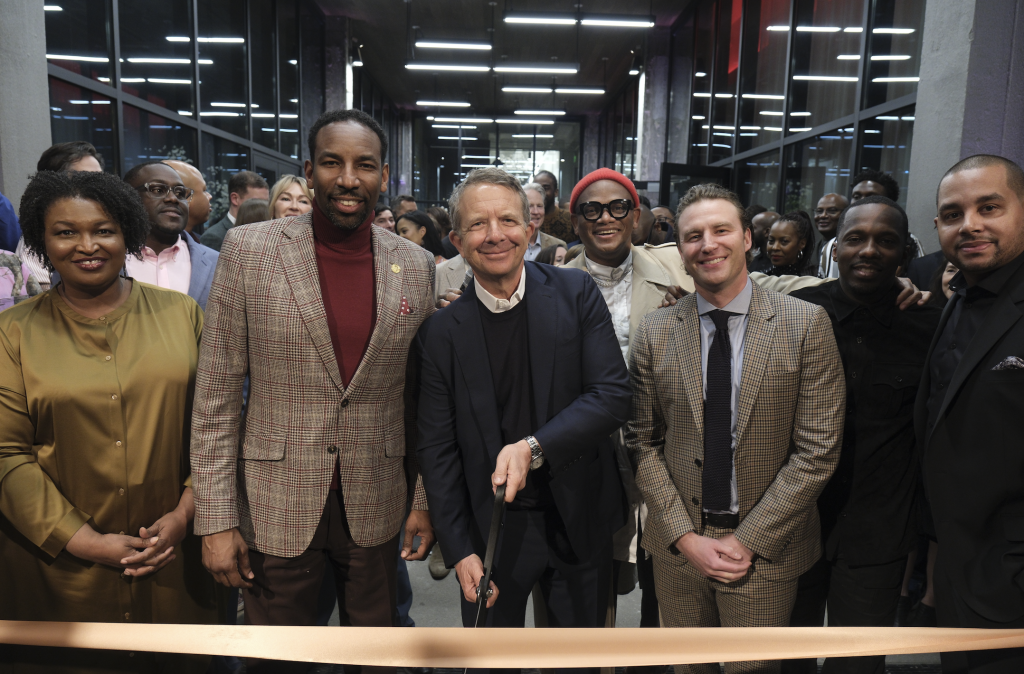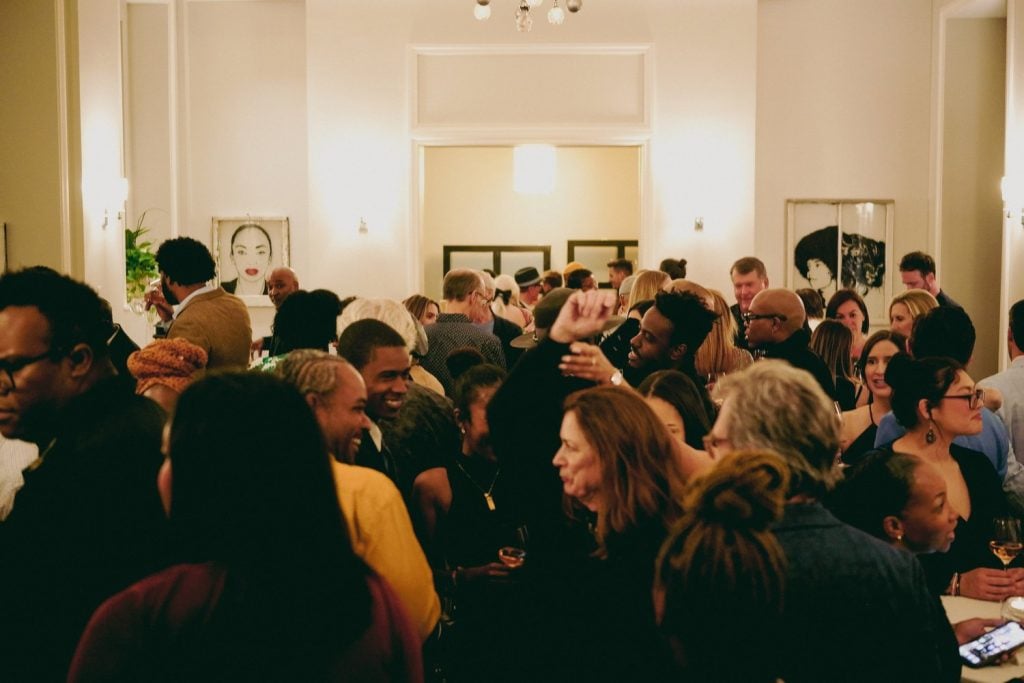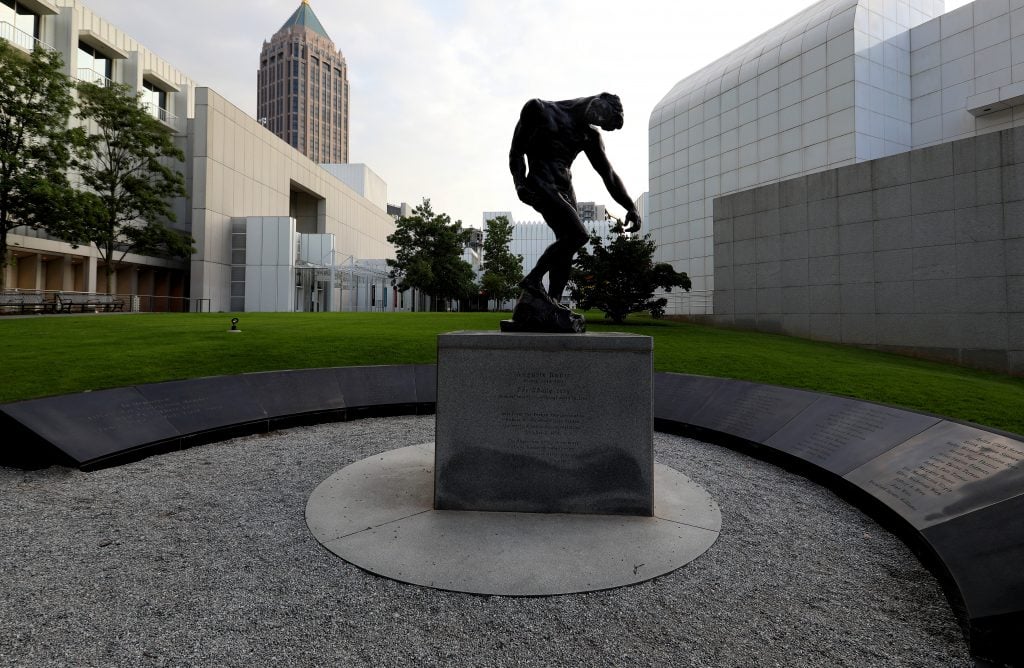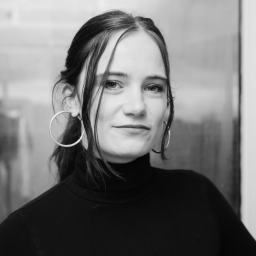Why hasn’t Atlanta, Georgia, become a hub for the visual arts the way some of its Southern sister cities, like Dallas or Miami, have? Despite a rich tradition of producing some of our most beloved contemporary artists—Radcliffe Bailey, Shara Hughes, Lauren Quin, and Roe Ethridge, to name just a few—the answer is surprisingly simple, and tragic.
In 1962, Air France flight 007 took off from Orly in Paris bound for Atlanta’s Hartsfield-Jackson airport, only to crash a few minutes later. Of the 131 people on board, only two flight attendants survived. The following day, Andy Warhol painted 129 Die in Jet!, which imagined a cover of the New York Mirror commemorating those lost in the crash.
A full 106 of those passengers were among Atlanta’s most esteemed and dedicated arts patrons, returning from a trip sponsored by the Atlanta Art Association to engage with museums in London, Amsterdam, Zürich, Rome, Florence, Lucerne, and Paris.
It marked “the day Atlanta stood still,” as Pulitzer-prize winning journalist Eugene Patterson put it. “It is doubtful that any American city ever lost at a single stroke so much fineness.”
The consequences of the horrific crash, which was the most deadly to date, are what many in Atlanta blame for the arts community’s failure to launch. The crash occurred at a pivotal moment, when Atlanta was on the cusp of desegregation and making sweeping changes to attract commerce.
“The impact on the city in 1962 was comparable to New York of September 11,” Ann Uhry Abrams, who wrote a book about the crash, told the Atlanta Journal Constitution on the incident’s 40th anniversary.
The Louvre loaned Whistler’s Mother by James Abbott McNeill Whistler—a favorite among the tour group—to the High Museum of Art in Atlanta as a gesture of sympathy for the grieving city. Meanwhile, the French government donated Auguste Rodin’s mournful bronze figure The Shade, which still stands in the center of the High Museum’s courtyard to this day.
The day before the group of board members, collectors, patrons, and artists embarked on their trip to Paris, they voted to put significant effort, via organizing and fundraising, into elevating the High Museum of Art from a regional museum into a world-class institution.
IF YOU BUILD IT, THEY WILL COME
Over the next several decades, as Atlanta struggled to regain its footing in the cultural landscape, its focus returned to the local.
Galleries started springing up in the 1980s and 1990s, and with them a new a collector base. In 1978, for example, Judith Alexander opened Alexander Gallery, dedicated to southern folk artists, including Nellie Mae Rowe. When Leo Castelli and Mary Boone were making waves in New York during the 1980s, art dealer Fay Gold took it upon herself to “bring the New York artists to Atlanta,” where she planned to teach painting at a local art school, she told Artnet News.
“I became a serious collector, buying Andy Warhol from Leo Castelli,” she said. “I brought Oldenburg, Warhol, Basquiat, Haring down to the South.”
She opened her gallery in Atlanta in 1980 with a group show of some of the artists she collected in New York. As she put it: “No one knew Atlanta existed then, besides Fay Gold!”
Gold’s gallery went on to put Atlanta on the map by showing at global art fairs such as FIAC, Art Basel, and Frieze. Eventually she was entrusted to represent the estates of Robert Mapplethorpe, Louise Nevelson, and Milton Avery, while showing local discoveries, such as Radcliffe Bailey.
“Local collectors would come to my gallery with pink and green color swatches for their interior design, and none of the art matched,” she said, noting Atlanta’s collectors’ main interest in decorative art. “Basically, the Southern [collectors] wanted what their grandmother had.”
Jane Jackson of Jackson Fine Arts found success in Atlanta by specializing in fine art photography. She opened in the city’s Buckhead neighborhood in 1990, just a few years before Elton John and his prolific photography collection migrated down from New York City. (She would eventually be named director of his collection.)
“Atlanta is a city of opportunity and growth. There are already wonderful art enthusiasts and collectors living here who have supported the arts for over 20 years,” said Anna Walker, the gallery’s director. Jackson’s clients have included Usher, Jon Bon Jovi, Ingrid Sischy, and Chris Rock. New business is also coming in, she said, and growing “at an unprecedented rate, bringing with it younger, more diverse, and sophisticated audiences who are looking for a more balanced life. Have you seen how green our city is in the spring? It is breathtaking.”
Among some of those new collectors in the city are Sara and Jon Schlesinger, who recently moved their collection from San Francisco to Atlanta, and have been enthusiastically purchasing work by local artists. In March 2020, the couple donated 110 works, including pieces by Damien Hirst, Daniel Arsham, David Altjmed, and Mike Kelley, to the Georgia Museum of Art.
Meanwhile, startup mogul and collector George Wells at the same time donated his $1 million collection to the historically Black Morehouse College, saying, “I thought, if in 100 years, people wanted to see what human civilization was up to, specifically the Black community in Atlanta—I want to connect the art to the cultural institution that’s had the highest impact on my life.”
HOLLYWOOD OFFERS HOPE AND HURDLES

The ribbon-cutting ceremony for UTA Artists Space Atlanta, with politician Stacey Abrams, Mayor Andre Dickens, UTA CEO Jeremy Zimmer, Co-Head of UTA Atlanta Steve Cohen, KLUTCH Sports Group’s Rich Paul, Co-Head of UTA Atlanta Rob Gibbs.
Atlanta’s film tax credit has moved huge amounts of Hollywood money to the city, and with it came more infrastructure for artists. Companies that spend $500,000 on production and post-production on movies or TV shows filmed in Georgia receive a 20 percent tax credit, thanks to the Georgia Entertainment Industry Investment Act. This has led to a flood of productions moving from L.A. film lots to the Southeast.
Last month, the Los Angeles-based talent company United Talent Agency, which has maintained a fine arts division in Tinsel Town since 2016, pulled the trigger on opening a permanent gallery in Atlanta, just across the street from the High Museum, in a building attached to its offices.
UTA had been programming pop-up shows in Atlanta’s hip Pullman Yards area for nearly a year. It kicked off with a show of work by Los Angeles artist Mario Joyce, followed by a string of Southern artists.
“Atlanta is a temporary home to so many incredible storytellers and artists working on film and television productions,” said talent agent Steve Cohen, who is co-head of UTA Atlanta. “But there is also an abundance of emerging Southern voices who reside here who make Atlanta a natural city in which to plant out flag.”
Fay Gold put it more plainly: “The reason Atlanta has galleries is because of the transplants from other cities who want art… You’ve got a lot of sophisticated people moving into the city. You have a lot of people coming in here who know about art.”
The ephemerality of so many of Atlanta’s residents is almost an inside-joke among local artists. Last fall, a group of local artists launched Temporary Art Center as a pop-up space during the inaugural Atlanta Art Week, based around that very phenomenon.
“Everything in Atlanta is temporary,” said one of the founders, artist Scott Ingram, who has lived and worked in Atlanta since the 1990s. “Pop-up shows work better here than gallery shows.”
Ingram is one of many artists who work out of Temporary Studios, also named for the sentiment. Many of the artists who work there have gallery representation—including by Portland’s Addams and Ollman, Chicago’s Kavi Gupta, and New York’s Derek Eller—but none of them have a dedicated gallery in Atlanta.
“No one really feels challenged by gallerists here. I haven’t worked with one for years,” said Ingram. Nor has artist Lonnie Holley, who has had his studio in Atlanta since 2010. He works with Blum & Poe in Los Angeles and Edel Assanti in London.
“They don’t have the outreach I had,” said Gold. “It’s not easy running a gallery; it’s a very expensive proposition.”
Some Atlanta artists today are finding more work in the entertainment industry than in visual art. Antonio Darden, another artist who works out of Temporary Studios, told me he estimates that 75 percent of his artist friends are members of the Union Behind Entertainment, the union for film set employees (which costs $1,500 to join).
According to Darden, this economic boost is a double-edged sword. “I did it and the work nearly killed me. It wasn’t worth the money,” he said of long shoot days that left him feeling too depleted to work out of his art studio.
AN EYE TO THE FUTURE

Atlanta Art Week’s launch party hosted by Johnson Lowe in 2022 at the Waldorf Astoria. Photo by Kia Tavernier.
The genesis of Atlanta’s contemporary arts community is marked by the unique set of circumstances that deprived it of the financial resources that could have given it a world-class museum, a dedicated group of moneyed collectors, and a traditional gallery system that comes with that. On the other side of the coin, Atlanta was given a carte blanche to create a unique arts ecosystem that isn’t dictated by the traditional status quo.
“Everyone who visits says Atlanta is reminiscent of L.A. 10 years ago—but we’re different, there’s a certain flair, and we’re so excited that the city is finally starting to receive recognition for its contributions to the arts,” said Kendra Walker, who launched the first edition of Atlanta Art Week last year for local galleries to join together to host events across the city. In October, the event is expanding to invite non-local galleries to come showcase in Atlanta.
“We want Atlanta Art Week to be a catalyst to the growth of the city’s art scene by bringing everyone together and shining a spotlight on this arts hub.”








